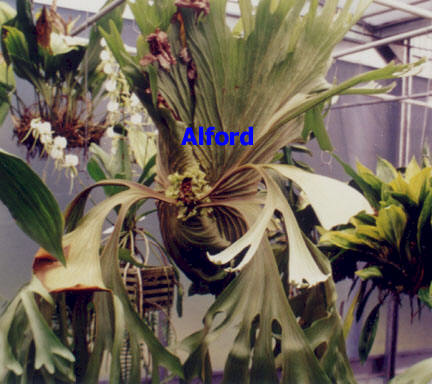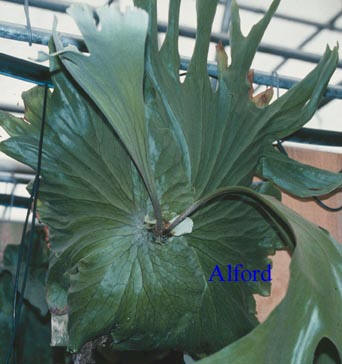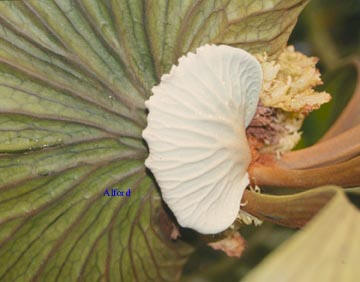| Wand |

Platycerium Charles Alford |
| Mr Charles Alford was propagating some P. wandae spore and to his surprise something new popped up. Initially it was thought to be a sport of P. wandae. Meaning it was a little different from the standard P. wandae. But after several decades of establishing the P. charles alford, he has concluded it is a hybrid cross of P. wandae and P. ridleyi. This happens when the prothalia of each species get commingled and a new hybrid is born. New hybrids are quite rare; most new variations are considered sports of the mother plant. Only after many decades of established growth, with new platys established with the same chrematistics, can we feel comfortable that its a hybrid and not a sport. |
 
The photo on the left is aparently an older established P. charles alford with shield fronds like a P. wandae. The spore lobes are singular whereas the P. wandae has two spore patches. The photo on the right is younger and is reminiscent of P. ridleyi with the shield hugging the mount and fertile fronds growing vertical like a P. ridleyi. I assume the spore lobes will develop soon and the fronds will droop down. |
 
The P. charles alford grows a single, raised, flat, triangular lobe with frills around the bud. New plants have been grown from P. charles alford spore and the cultivar encompasses the original, and the progeny. If it was a sport/cultivar plants grown from spore would probably not resemble the cultivar providing spore.
For more information on the P. charles alford the reader is encouraged to visit RareFerns.com |
|
The reader must realize that many hybrids are a result of accidental mixing of spore when similar plants are grown in close proximity. Even when spore from two species are intentionally crossed, it is always possible for a spore from an unintended species to contaminate the intended cross. After repeated attempts and proof that their progeny have the same traits, then we can agree as to the parentage and define it as a new hybrid and not just a sport or cultivar of a species. This can take a long time with slow growing platyceriums and experienced growers are hesitant to jump the gun and name a hybrid. So when we discuss hybrids, we need to consider all the variables. Soon we will have more definite DNA studies. Until DNA testing is more readily available, and established parent base lines defined, we must look at and compare traits from other species and deduct a logical inference to the actual parentage and these are considered individual plants and not necessarily a hybrids.
|
|
[
Plant Glossary ] |